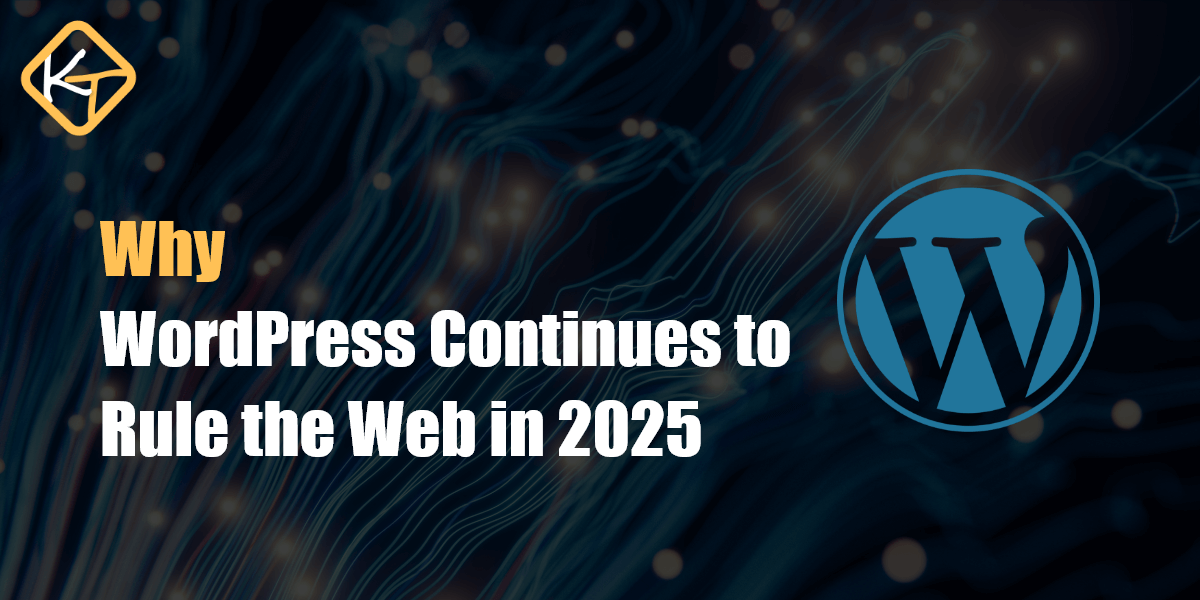
WordPress is not just another website builder it’s the platform that has transformed how we create and manage content online. In 2025, it still powers nearly half of the web, supporting websites from simple personal blogs to enterprise-grade e-commerce platforms. Its dominance is not accidental. Instead, it’s the result of years of evolution, community-driven development, and adaptability to new technologies.
While new tools like Wix, Squarespace, Webflow, and AI-powered site builders continue to enter the market, WordPress has maintained its stronghold. The question is, why WordPress continues to rule the web in 2025? The answer lies in its unique balance of flexibility, affordability, usability, and scalability. Let’s explore why this two-decade-old platform still dominates the internet.
The Historical Growth of WordPress
WordPress started in 2003 as a simple blogging tool. Back then, its primary purpose was to make publishing content online easier. However, its open-source foundation allowed developers worldwide to contribute, shaping it into a powerful content management system (CMS).

Over the years, it grew from being just a blogging platform into a robust ecosystem capable of supporting any type of website. Governments, universities, global brands, and small businesses alike began using it. By consistently evolving to meet the demands of the digital world, WordPress secured its place as the backbone of nearly half the internet by 2025.
Why WordPress Continues to Rule the Web in 2025
Flexibility and Versatility
One of WordPress’s greatest strengths is its flexibility. It can handle everything from personal blogs and portfolios to membership sites, online stores, and news portals. With the Gutenberg block editor, users can now design websites using an intuitive, drag-and-drop system. Developers, meanwhile, can push its limits with custom themes, APIs, and integrations.
This versatility ensures that no matter what type of website you need, WordPress can deliver. That’s a major reason why it remains the number one CMS even in 2025.
Ease of Use for All Levels
Despite being powerful, WordPress is easy for beginners to use. Non-technical users can publish blog posts, upload media, and adjust site settings without writing a single line of code. At the same time, advanced developers can dig into the backend, customize themes, and build completely new functionalities.
This ability to cater to both beginners and professionals sets WordPress apart from many other platforms that lean too heavily in one direction.
Affordability and Cost-Effectiveness
WordPress itself is free. All you need is hosting and a domain name. Compared to subscription-heavy platforms, WordPress offers more freedom and lower long-term costs.
Businesses of all sizes, from startups to enterprises, benefit from this affordability. In 2025, when SaaS platforms continue raising prices, WordPress remains a cost-effective solution that gives complete ownership and control of your website.
Plugins and Theme Ecosystem
The plugin and theme ecosystem is one of the biggest reasons for WordPress’s continued dominance. With over 60,000 free plugins available (plus countless premium ones), users can extend their websites with new features—SEO, contact forms, security, analytics, e-commerce, and more.
Themes allow easy design changes, ensuring websites look professional without expensive design costs. In 2025, many plugins and themes even integrate AI, making them smarter and more efficient.
SEO Superiority
SEO remains a top priority for anyone with an online presence. WordPress was built with SEO in mind, offering clean code, customizable URLs, and fast-loading designs. Plugins like Yoast SEO and Rank Math make optimization easier, offering real-time feedback and keyword suggestions.
In 2025, as AI-driven search engines become more sophisticated, WordPress continues to provide tools that help businesses maintain strong visibility.
WooCommerce and E-Commerce Power
E-commerce is booming, and WooCommerce, WordPress’s e-commerce plugin, is one of the most widely used solutions globally. It allows businesses to build online stores that are scalable, customizable, and integrated with modern payment gateways.

From selling a handful of products to running global online marketplaces, WooCommerce provides unmatched flexibility. In 2025, it continues to dominate because it grows with businesses instead of limiting them.
Security and Reliability
Given its widespread use, WordPress is a common target for hackers. However, continuous updates, strong security plugins like Wordfence and Sucuri, and secure hosting environments keep it safe.

By 2025, AI-driven security tools have become part of the WordPress ecosystem, providing proactive protection. This commitment to security reassures users and keeps businesses online without disruptions.
Global Community Support
No other CMS has a community as large and active as WordPress. Developers, designers, and users contribute daily by creating plugins, writing tutorials, organizing WordCamps, and answering questions in forums.
This global community ensures that anyone using WordPress has access to resources, help, and updates. The collaborative nature of the community also guarantees continuous growth and innovation.
Adaptability to New Technology
Perhaps the most important reason WordPress rules the web in 2025 is its adaptability. The internet changes rapidly, yet WordPress always evolves. From being just a blogging tool to becoming a headless CMS, from introducing block editing to embracing AI integration, WordPress adapts faster than most competitors.
In 2025, many developers use WordPress as a backend (headless CMS) while delivering front-end experiences with frameworks like React and Vue. This adaptability makes WordPress future-proof.
WordPress as a Tool for Businesses and Enterprises
WordPress is not just for bloggers and small businesses. Major corporations, media outlets, and governments use it too. Enterprises choose WordPress because it’s scalable, secure, and customizable. It can integrate with CRMs, ERP systems, and advanced analytics tools.
For startups, it offers a cost-effective way to establish an online presence. For global brands, it delivers enterprise-grade performance. This range of use cases makes it the most versatile CMS in the market.
The Future of WordPress Beyond 2025
Looking ahead, WordPress shows no signs of slowing down. With AI integration, headless CMS capabilities, and continuous updates, it will remain relevant for years to come.
Future innovations will likely focus on automation, improved user experiences, and deeper integrations with emerging technologies like voice search, AR/VR, and Web3. As long as the community stays strong, WordPress will remain at the center of web development.
Conclusion
The dominance of WordPress in 2025 is not a coincidence. It is the result of flexibility, affordability, SEO strengths, powerful e-commerce features, strong security, and a thriving global community. While competitors exist, none offer the same balance of simplicity, power, and adaptability.
That’s why WordPress continues to rule the web in 2025 and why it will likely remain the foundation of the internet for many years to come.
If you’re planning to build or redesign your website, WordPress is still your best choice in 2025. And if you want expert help with creating a professional, SEO-friendly, and scalable website, contact us today—we’ll bring your vision to life.
